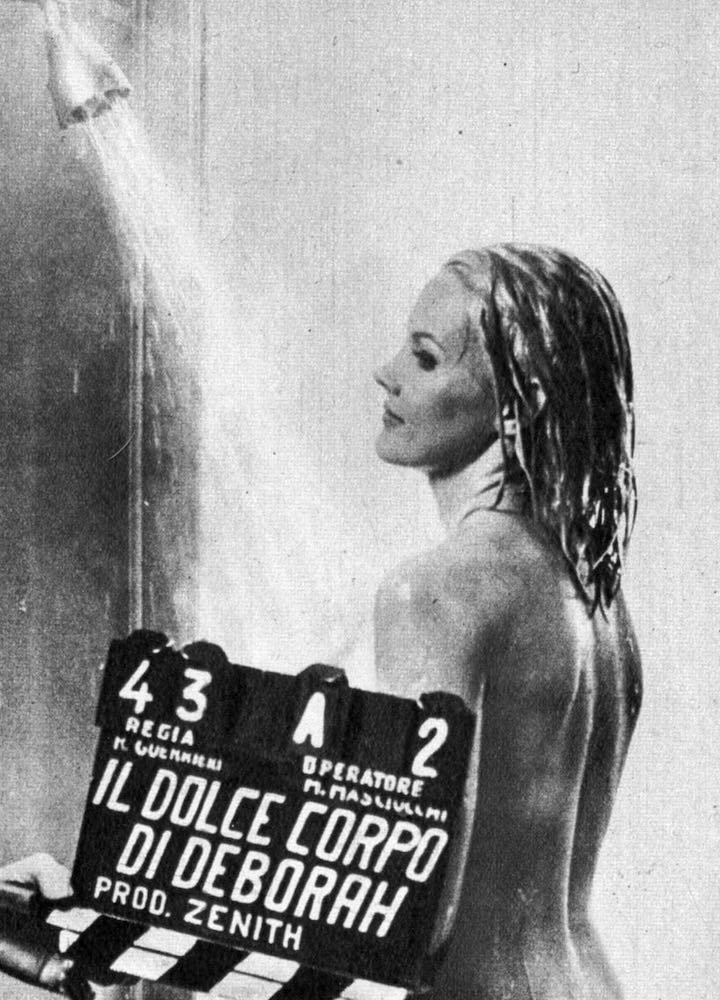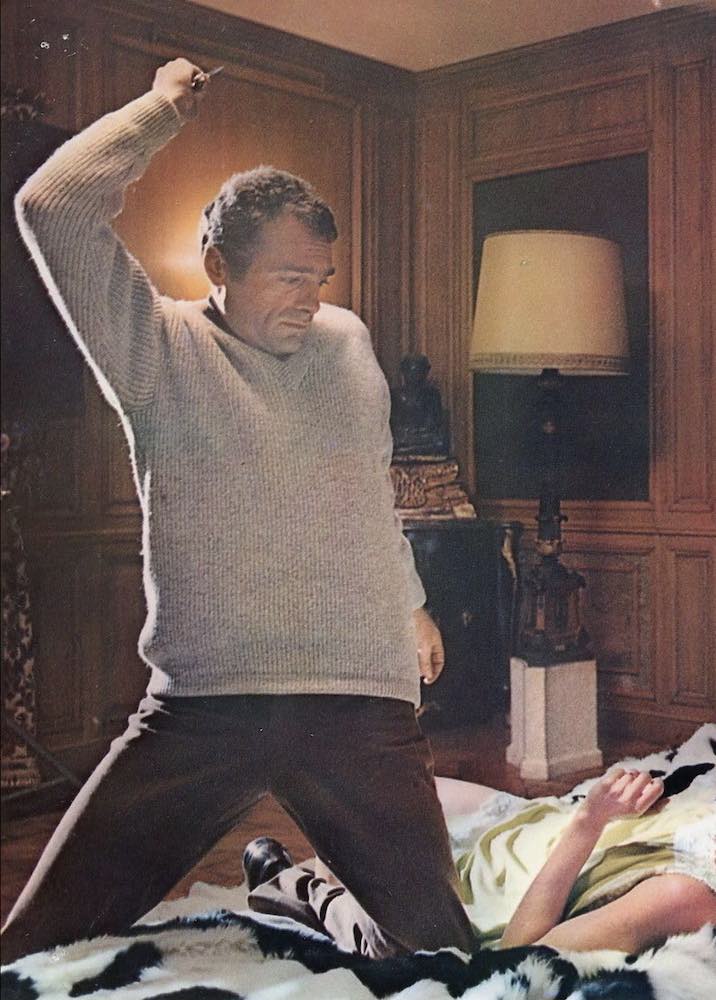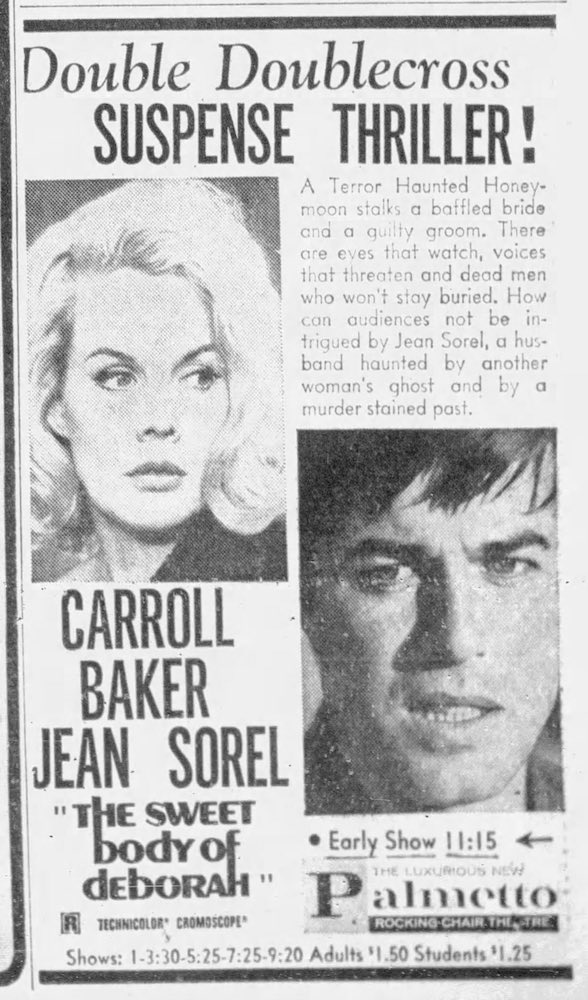


Italy/France, 1968
Review:
JA Kerswell
Although not as well remembered today, Romolo Guerrieri’s THE SWEET BODY OF DEBORAH was just as influential in its own way for the development and popularity of the Giallo as Dario Argento’s later THE BIRD WITH THE CRYSTAL PLUMAGE (1970). A honeymooning couple is menaced by an old friend who accuses the husband of causing the suicide of his ex-girlfriend. The question, however, is: who is the villain and who is the victim? The film—which is soundtracked by the suitably languid jazz of Nora Orlandi—features a veritable who’s-who of faces that would come to dominate the genre over the coming few years.
Carroll Baker plays the eponymous Deborah, who has travelled to Geneva from her home in the United States to celebrate marrying her handsome husband Marcel (Jean Sorel). However, the celebrations are short-lived when Marcel spots an old friend, Philip (Luigi Pistilli), who snubs him at a nightclub. Accosting him outside, Philip testily tells Marcel that he blames him for the death of Suzanne (Evelyn Stewart)—who supposedly killed herself after he left for the United States.
Marcel tells Deborah that he had had a love affair with the rich Suzanne but left to make his fortune abroad—and completely forgot about her once he met Deborah. Seemingly wracked with guilt at abandoning Suzanne, Marcel insists they go to her old mansion, only to find it abandoned and largely empty. However, whilst investigating, the couple are tormented by the sounds of someone playing Suzanne’s favourite song on the piano. They also find a lit cigarette with lipstick on it, and Deborah picks up a ringing phone to be told that she must die to pay for Marcel’s crimes!
Can the couple unravel the mystery before the killer makes good on his or her promise? And just why has their handsome artist neighbour Robert (George Hilton) taken to spying on them whilst they play Twister in the garden?
Those used to the one-by-one murders at the hands of a black-gloved killer—in a formula perfected by Dario Argento and developed from Mario Bava’s archetype BLOOD AND BLACK LAC
E (1964)—may need to check their expectations. While THE SWEET BODY OF DEBORAH pioneers erotically charged Gialli, it is pretty light on explicit violence (with only one on screen death). Indeed, at only one point are characters menaced with a knife. However, there is still a lot of fun to be had here.
Featuring beautiful, rich people doing terrible things to each other in impossibly glamorous locations, the film’s narrative structure—with a script by Giallo maestro Ernesto Gastaldi— creates a template for many future examples in the genre. The film liberally borrows from Henri-Georges Clouzot's influential French thriller LES DIABOLIQUES (1955) and George Cukor’s earlier GASLIGHT (1944). Although the film’s multiple twists during its final 30 minutes—where each character’s motivations switch between hero and villain a number of times—might now seem familiar to any seasoned Giallo viewer, it was a sensation at the time—and made the film a major box office hit in its home country.
The film’s travelogue approach—where the action spans multiple countries (from snowy Geneva to sun-kissed Nice)—was just one of the tropes that would soon pepper future examples. Others are the sports event as a backdrop for a scene (here a large boxing match) and the watching of strip burlesque in a nightclub (fetishising a black female dance became so common that actress Nieves Navarro (aka Susan Scott) even donned blackface to do it in Luciano Ercoli’s DEATH WALKS IN HIGH HEELS (1971)).
THE SWEET BODY OF DEBORAH also features another future trope where slightly out-of-place protagonists (both Baker and Sorel were in their 30s) would frug away to the latest happening tunes at a nightclub with the teenage set. And what a nightclub! It is a riot of pop art, with the walls adorned with giant images of superhero comic book characters. It even features a shifty-looking George Hilton painting petals on the face of a female flower child as he furtively watches the pair dancing.
The pop-art excesses extend to Carol Baker’s wardrobe, where she wears an all-in-one bright green full-body leotard to play Twister in the garden of their Honeymoon villa. She also sports an eye-popping outfit that looks to be adorned in blue Christmas baubles. Elsewhere, the film displays less of the excess that would soon become widespread in the genre. The film’s eroticism and nudity would very probably have been scandalous at the time—and whilst both Baker and Sorel show a little skin, it is pretty mild stuff.
Outside of the Russian Doll’esque ending, THE SWEET BODY OF DEBORAH does feature some other deliciously daft touches that should delight any Giallo fan. Such as Deborah’s answer to being menaced by the killer on the phone is to put on a voluminous chiffon nightie. Or when Marcel’s idea of a pick-me-up for Deborah’s near-fatal overdose on tranquilisers is a full tumbler of neat whiskey!
Caroll Baker became the first queen of the Giallo. The North American actress—like many before and after her—fled the United States for a time to escape from something (in her case, a box office failure, a legal dispute with Paramount Studios, and all but being blacklisted by Hollywood). The Italian press called her an “American diva” and were intrigued by her sexuality (she had previously posed for Playboy in December 1964). Filmed in 1967, her appearance in THE SWEET BODY OF DEBORAH, in large part, drove the film to an impressive 587 million lire take at the Italian box office. Before the year was out, she appeared in Umberto Lenzi’s ORGASMO, as well as a slew of other gialli until the mid-1970s. The success of the film also made sure that Jean Sorel made regular appearances in the genre, and was reunited with Baker in Lenzi’s A QUIET PLACE TO KILL (1970) - not to mention the burgeoning giallo careers of Hilton, Pistilli, and Stewart. Director Romolo Girolami went on to direct the giallo THE DOUBLE (1971).
THE SWEET BODY OF DEBORAH was dubbed by the Italian press as a Hitchcock-style thriller and largely praised on its release. Newspaper La Stampa called it a “decent, professional film” and teased audiences with its twists, which it called “double somersaults at the end.” Despite its successful Italian bow, the film did not replicate this success in the UK or US. It was hampered by being slapped with an X-rating (in the US no one under 16 admitted), and didn’t hit a nerve with stateside audiences in 1969. Possibly because there were much more shocking and explicit films on release—although the advertising for the film did try over-emphasising Baker’s sexuality with such breathless taglines as: “She Had Warm Eyes - Cold Knife - Sweet Body - Bitter Revenge” and “Aflame with female power!”. The Los Angeles Times dismissed it as: “Not nearly good enough to play an art theater, not nearly sexy enough for exploitation purposes.”
Thankfully, THE SWEET BODY OF DEBORAH’s success at the Italian box office meant that the ground remained fertile for the Giallo to keep developing—and it is possible that, without it, the likes of Dario Argento, Umberto Lenzi and Sergio Martino wouldn’t have been inspired to carve out their own niches in the genre.
BODY COUNT 1:
Female 0 / Male 1
Thank you for reading! And, if you've enjoyed this review, please consider a donation to help keep Hysteria Lives! alive! Donate now with Paypal.
English Language Trailer for THE SWEET BODY OF DEBORAH (1968)